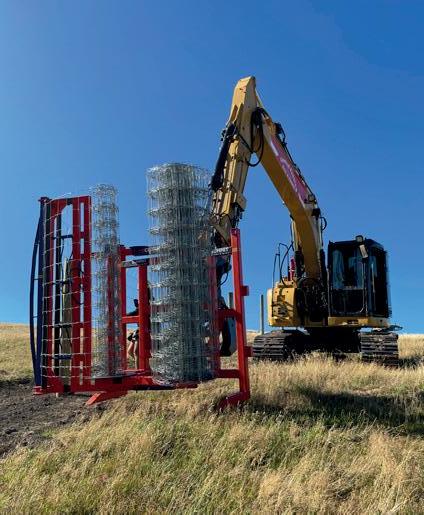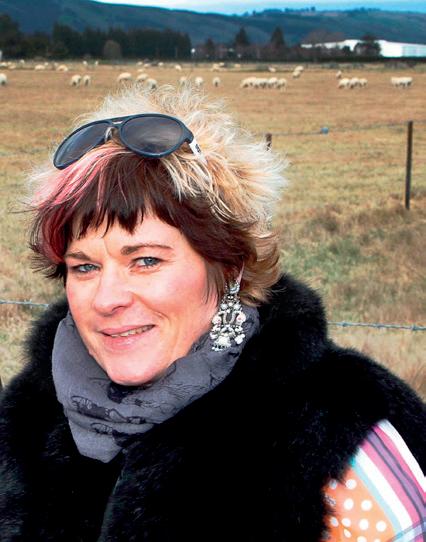
8 minute read
Keep calm and reduce lameness
Veterinarian Neil Chesterton recently spoke to a large group of dairy farmers in Dunsandel and Hinds in Canterbury about ways to reduce lameness in dairy cows and how to improve cow flow.
More than 80 Synlait dairy farmers attended each session to gain insight into the factors that contribute to lameness in cows and how to prevent it. Neil Chesterton has been a vet in dairy practice in Taranaki for almost 40 years and is well known for finding practical answers to reduce lameness in dairy cows. His studies identified that the two main areas of risk for foot damage in pasture-based systems are the walking surface of the track and the management of the herd — both on the track and in the milking yard. Neil has travelled internationally to investigate lameness problems and to train farmers and vets in low-stress herd handling, while improving cow-flow into and out of the milking shed. The seminars came about following a brainstorming session with the Farmlands Growth and Innovation team and Synlait last year, Farmlands Head of Nutrition & Animal Health Dr Robert Derrick explains.
Different types of ailments
“Studies have been done in New Zealand suggesting that an average of 26 percent of the cows in large herds have some form of lameness over the course of a full year, so it’s widespread,” Dr Neil says. Just four lameness conditions account for about 90 percent of the lameness in pasture-based farms in New Zealand. These are: white line injury, sole injury, axial wall damage and foot rot. Lameness in dairy cattle in New Zealand is mainly associated with injury and infection. • White line injury: This is a lameness condition affecting predominantly the lateral claw of hind feet in adult cattle and the medial claw of the front feet in heifers.
Stress and handling under pressure in the collecting yard and the tracks increases the risk of white line separation. This initial separation allows entry of foreign material and an abscess to form under the wall. After about 2 weeks the abscess works its way up towards the coronet and bursts out. The main sign of pressure handling is to see cows with their heads up over the backs of other cows. • Sole injury: Another common foot issue causing lameness is sole injury. This could be a sole bruise but more commonly lameness is caused by a sole puncture wound. This puncture can develop into an abscess that Dr Neil says
“works its way underneath the sole and bursts out between the claws.”
Kiwi cows are used to walking distances to and from the milking shed and if allowed to walk at their own pace, are very good at avoiding stones that might damage their soles. Stressed cows with their heads up can’t see where they are treading and can’t pull up their hooves quickly to relieve pressure if they do tread on something sharp. • Axial wall damage: Cracks between the toes or axial wall damage, are also quite common. These start with an injury caused by a stone jammed up between the claws at the top of the hoof. For example the cow may have had (treated) foot rot 3 months earlier but the injury can grow further down the hoof, causing cracks in the axial hoof wall.
• Foot rot: This is initially caused by an injury breaking the skin between the claws, followed by a bacterial infection, most commonly Fusobacterium necrophorum.
Once the injured skin is infected, the foot swells and is very painful. If treated early with antibiotics the pain and swelling rapidly heals.
Neil’s presentation titled “Understanding Lameness – the importance of improving cowflow to reduce the damage to the foot”, revealed that incorrect herd management was surprisingly common and contributed to poor animal health and lost productivity. “Most claw-horn disruption lameness has been associated with improper handling, damaging walking surfaces, as well as flighty animal behaviour. Careful, low-stress handling and proper flooring may help prevent this from occurring,” Dr Neil says.
Good cow flow is key
“Within a herd there will always be dominant cows and passive cows and (just like a group of teenagers) it is this dominance of certain cows that affects all herd behaviours,” Dr Neil says. “In this way, herds are a bunch of individuals that observe social rules and they need routine. They are creatures of habit and it is up to the farmer to create good routines for them. “50 percent of the dominant cows are in the front third of the herd. The rest are spread throughout the herd and these cows control the herd walking speed. “Dominant cows draw cows behind them as they move forward and cause cows in front of them to hurry along often by giving them a bunt. “There is a walking order and a milking order — and they are different. Cows need time and space to readjust from a walking order to a milking order after they arrive at the milking shed. “If cow flow is poor, then adjustments to facilities and procedures can be made to make milking an ‘exercise in contentment’. “Not only will people perform better, the cows will respond by flowing more smoothly. A content herd will have better milk let down, produce more, have a lower cell count and less foot damage. “The cow is a creature of habit — changes will confuse her, so therefore we need to maintain the same routines every day. “But the cow is also adaptable, every day is a training experience for the cow – either good or bad.” A cow allowed to express normal behaviour as an individual and in the herd will behave in certain predictable ways and the herd will flow well and be content. Poor cow flow is often the result of a lack of understanding of cow behaviour in the way people manage cows and in the poor design of facilities. The combination of understanding the herd, having consistent routines and giving the cows space, should result in good cow flow. Farmers in attendance gave some examples of routines that they find effective in improving cow flow, such as having a sprinkler on the milking platform on hot days to encourage cows to move as desired. Dr Neil concluded his presentation by saying while lameness may seem inevitable within a dairy herd, it can be managed and reduced though careful and calm herd management. The less stress on a cow, the less impact on her hooves and the way that animals are managed on the farm has a huge impact on herd health.
Tips for keeping your herd relaxed:
• Voluntary flow from the paddock, or keep 10 metres behind the last cow. • Have enough space in the collecting yard for your herd (1.3sqm for
Jersey cows, 1.5sqm for Fresians). • Delay the first movement of the backing gate for at least 20 minutes after the first row or rotation of cows has entered the bales. • Have consistent routines (e.g. filling the bales in the shed, cupping, teat spraying and exiting the bales, how you move the backing gate etc). • Cows prefer familiar people and surroundings. • Ensure you and your workers are calm and quiet – no rushing. • Use a gentle tone when speaking to the cows or to each other.
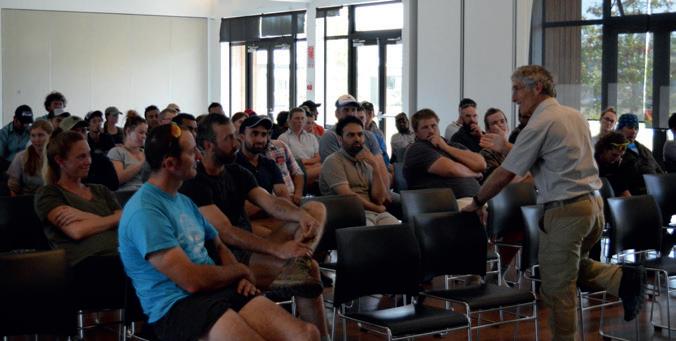
| Veterinarian Neil Chesterton addresses the crowd at Dunsandel.
For information visit www.lamecow.co.nz

QUALITY TIMBER FENCING & DECKING
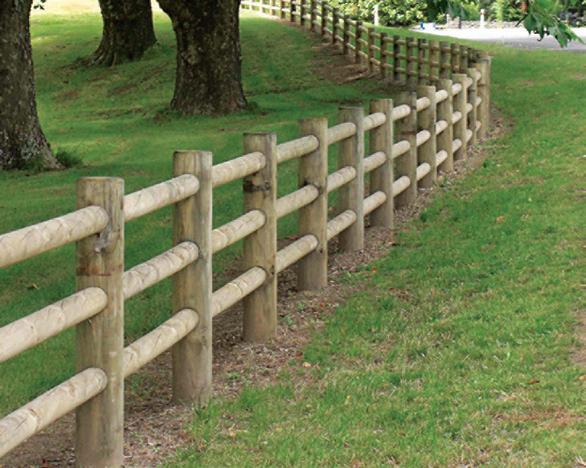
SelfLok Fencing
Made from the highest quality materials for outstanding durability, you can choose from a wide range of eye-catching designs with one, two and three rail options available. Plus, the easy to install self-locking system means no nails or glue are required.
AVAILABLE THROUGH SPECIAL ORDERS
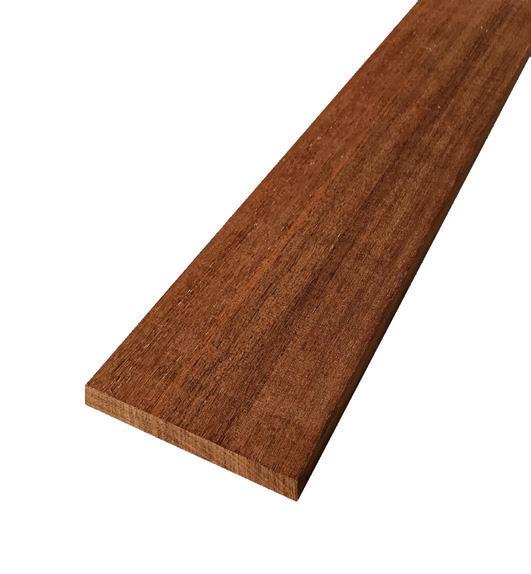
Farmlands Shareholder Price
00229506 SelfLok Post 3-Rail 180mm x 1.8m Homestead $58.96 incl. GST 00229507 SelfLok Post 3-Rail 200mm x 1.8m Signature $78.28 incl. GST 00229508 SelfLok Rail 123mm x 2.4m Signature $32.74 incl. GST 00229510 SelfLok Rail 113mm x 2.4m Homestead $28.97 incl. GST 00229511 SelfLok Post 1-Rail 180mm x 0.9m Homestead $43.04 incl. GST 00229513 SelfLok Post 1-Rail 180mm x 1.2m Homestead $45.86 incl. GST 00229514 SelfLok Post 2-Rail 180mm x 1.5m Homestead $50.55 incl. GST 00229515 SelfLok Post 3-Rail 180mm x 2.1m Homestead $61.66 incl. GST 00229516 SelfLok Post 1-Rail 200mm x 0.9m Signature $59.49 incl. GST 00229517 SelfLok Post 1-Rail 200mm x 1.2m Signature $63.25 incl. GST 00229518 SelfLok Post 2-Rail 200mm x 1.5m Signature $70.76 incl. GST 00229520 SelfLok Post 3-Rail 200mm x 2.1m Signature $82.01 incl. GST

SpecRite Kwila Pre-oiled Decking
Pre-oiled with Feast Watson® Industrial Timber Oil for 360° protection, SpecRite Kwila Decking is made from select grade, kiln-dried timber for greater stability and offers a consistent red-brown colouring that is easy to work with in terms of clean cutting and fastening.
00200172 90 x 19mm Kwila Smooth H/DW Decking Pre-oiled
Farmlands Shareholder Price
$749 PER LINEAL MTR
INCLUDES GST
00200173 140 x 19mm Kwila Smooth H/DW Decking Pre-oiled
Farmlands Shareholder Price
PER LINEAL MTR $1222
INCLUDES GST
To order or find out more contact Bunnings National Trade Support Team via email sales@bunnings.co.nz or 09 978 2200
*Not all services and products featured are available in all stores, but may be ordered. See in store for product availability. All prices quoted are exclusive to Farmlands shareholders and include GST.
Prices valid until Monday 31 May 2021 or while stocks last.


